Brazil Menas Daterra Estate Introduction Sunrise Coffee Bean Description
Brazil is the largest coffee producer in the world, accounting for about 30% of coffee production, but because Brazil is located in tropical rain forest areas with relatively flat terrain and few high-altitude mountain forests, most coffee is grown in low-altitude non-volcanic soil areas. And there is not much shade for shading, resulting in the disadvantage that Brazilian beans grow quickly, but the density and soft flavor of coffee does not change much. Coupled with large-scale machine harvesting of coffee beans with a wide range of maturity differences in coffee harvesting at the same time, so that the quality of Brazilian beans is not particularly outstanding has always stayed in the category of commercial beans.
After 2000, due to the inducement of coffee competition, the quality of coffee beans produced in the high-altitude areas of the south was appreciated, mainly by the farms around the Minas platform, and the coffee quality was also the largest among Brazilian beans, such as Sirado in the west of Minas and Matas in the east, Bashiya in the north or small farms in the south, Minas almost became synonymous with Brazilian boutique coffee. In recent years, the coffee competition is so accurate that it is separated by treatment (water treatment, half water washing, half sun drying), which has developed a variety of flavors and taste, which is completely different from that of traditional Brazilian coffee. In particular, the half-sun method and the sun method perform best, the aroma of clean low-acid fruit increases, so that the rich chocolate flavor is reduced.
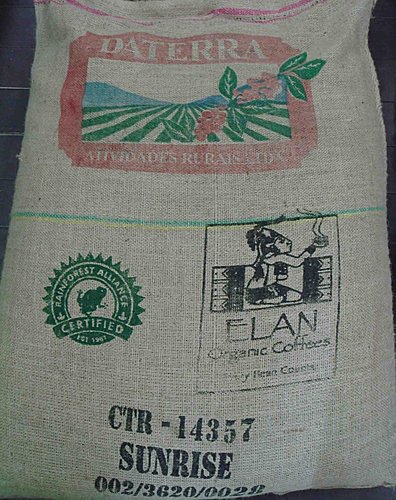
Daterra Manor in Brazil is a Brazilian sun-dried bean certified by the Forest Alliance.
Daterra coffee in Brazil has sprung up in the past year or two. Instead of being a single coffee farm, it brings the high-altitude coffee farms in the Minas Gerais region into a centralized middle and back section, then dries and bagges for centralized storage management, and sells it to the world under the name of Datra Coffee Farm (or company) through a novel marketing method. The member farms of Daterra Coffee are all above 1150 meters above sea level and the average annual temperature is about 22 degrees Celsius. The joining farms must comply with the spirit of the Rain Forest Alliance (RFA) to protect the primeval rainforest and improve the community living environment and family income of the participating members.
The coffee is sent from the production site to the treatment plant immediately after harvest, and the treated coffee water comes from the underground well water because no chemical composition is added to the process and can be used for irrigation without any damage to the natural environment. The Datra sun beans are slightly different from other natural sun drying methods in Brazil. After drying the raw beans on the bean drying farm for 3 days, the raw beans are moved to a dryer with hot water passing through the tube as a heat source to keep the temperature no more than 30 degrees Celsius. Until the overall humidity of the coffee bean drops to 11 percent, then move the coffee to a special wooden box, about 60 days later, the coffee has a uniform humidity and the same liveliness. It is not until the sales order is received that it is polished and packed in gunny bags. Datra Coffee (Daterra) is a top Brazilian coffee grown in the pristine rainforest and is the most important partner of the Rainforest Alliance in Brazil.
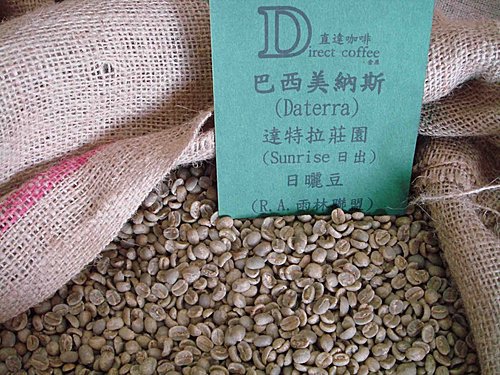
Daterra Manor in Brazil sun-dried beans have a black tea fragrance of green color.
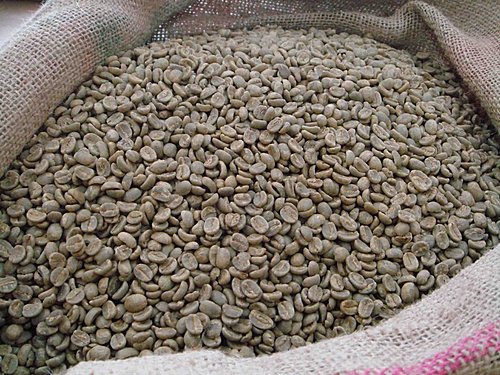
The introduction of Brazilian Datra coffee is named after Sunrise (the rising sun). The raw coffee beans have obvious aroma of black tea, and the overall color of raw beans is greener than that of the previous batch of Brazilian European Brown sun beans (Bloom has photos). It may be formed by the two-stage drying method of Datra sun beans, because the fruit of Brazilian sun beans is sour and sweet, and the beans can be laid earlier. Complete floral aroma and complex sweet taste can be obtained in shallow baking, while there is no bitter and uncomfortable piercing in the re-baking, and the taste is still warm and sweet.
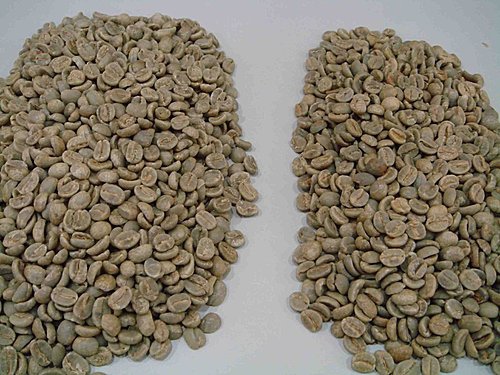
On the left is Datra sun beans, the color of raw beans is more bluish green, and on the right hand side is Obran sun beans, yellowish brown.
Shallow baking City (fragrance): Brazil Datra Manor sunrise beans in the light baking fresh green orange acidity is strong bright and high-pitched, which is rare in other Brazilian beans (acid close to Yegashev shallow baked grapefruit acid), but not long-lasting turn into orange water sweet, with a grand sesame peanut aroma, the whole taste complex and changeable, but does not jump out of the round feeling Huigan can smell the sweet smell of vanilla almonds from the nose.
Heavy baking (Full-City): this baking degree has a good soft and subtle cherry acidity, rich and smooth aroma of milk chocolate, clean light with smooth ester taste, honey maltose sweetness, sweet hazelnut as transparent and delicate as silk.
Important Notice :
前街咖啡 FrontStreet Coffee has moved to new addredd:
FrontStreet Coffee Address: 315,Donghua East Road,GuangZhou
Tel:020 38364473
- Prev
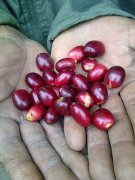
Isopiaya Gaschef Biloya (Biloya Cooperative) Coffee Bean Flavor introduction Baking suggestion
Ethiopia Yegashev Biloya (Biloya Cooperative) G2 Beloya or (Biloya) both names are used, which is correct? after searching for Google, I don't quite know, there are both kinds of information, but these are not important, tasty is the king. Coincidentally, Biloya and Kochere are in the same producing area, and coffee varieties are also Heirloom, if so.
- Next
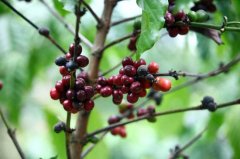
Introduction to the single-layer slow drying method of Holy Lion Benti Nenqua of Humbera Manor Hambela
The Holy Lion of Hambela (Hambela), the Holy Lion (Benti Nenqua), comes from METAD Agricultural Development Co., Ltd. and is a private family business, which also owns Hambela Coffee Estate. Located in the clothesline
Related
- Does Rose Summer choose Blue, Green or Red? Detailed explanation of Rose Summer Coffee plots and Classification in Panamanian Jade Manor
- What is the difference between the origin, producing area, processing plant, cooperative and manor of coffee beans?
- How fine does the espresso powder fit? how to grind the espresso?
- Sca coffee roasting degree color card coffee roasting degree 8 roasting color values what do you mean?
- The practice of lattes: how to make lattes at home
- Introduction to Indonesian Fine Coffee beans-- Java Coffee producing area of Indonesian Arabica Coffee
- How much will the flavor of light and medium roasted rose summer be expressed? What baking level is rose summer suitable for?
- Introduction to the characteristics of washing, sun-drying or wet-planing coffee commonly used in Mantenin, Indonesia
- Price characteristics of Arabica Coffee Bean Starbucks introduction to Manning Coffee Bean Taste producing area Variety Manor
- What is the authentic Yega flavor? What are the flavor characteristics of the really excellent Yejasuffi coffee beans?

